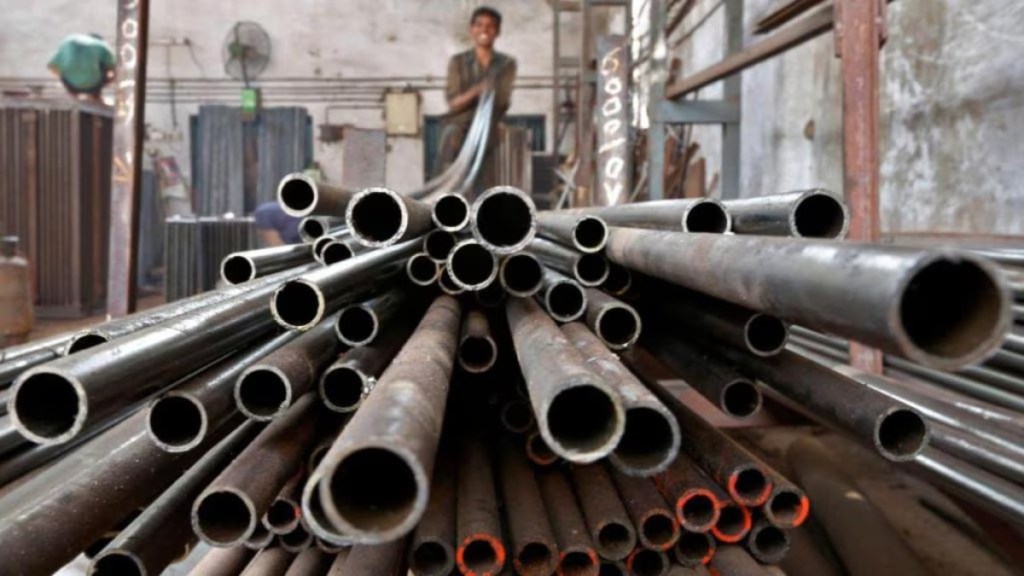By Amriteshwar Mathur
The steel industry has been facing multiple headwinds with surging steel imports from south-east Asian nations over the past few quarters along with sluggish growth trends in the domestic economy, given a slowdown in government spending on infrastructure projects.
It’s no surprise that steel companies reported near 8-9 % y-o-y fall in realisations on a per tonne basis in the December 2024 quarter along with a sharp drop in net profit in the quarter under review.
And nervous investors on Dalal Street have heavily sold stocks in this sector – the government-controlled SAIL ended Wednesday’s trade at Rs 104.4, and not too far from its 52-week of Rs 99.55 that was reached on 13 January 2025. In addition, Tata Steel ended Wednesday’s trade at Rs 130.8, while its 52-week low of Rs 122.6 was also on 13 January 2025.
Brittle strength of steel sector
Media reports have pointed out to Chinese steel imports into the country that grew nearly 23 % on a y-o-y basis to 1.96 million tonnes during April to November of the current financial year. In addition, steel imports from Japan more than doubled to 1.4 million tonnes during this period.
The above development comes at a time when the economy has shown signs of losing pace – the RBI had downgraded real GDP growth forecast to 6.6 % for FY 25 from the previous forecast of 7.2 per cent in its quarterly monetary policy review meeting in early December 2024.
It’s no surprise that steel realisations for leading players like JSW Steel, realisations declined nearly 8.9 % y-o-y to Rs 56,885 per tonne in the third quarter of FY 25 in its Indian operations. JSW Steel on a standalone basis, which includes its Indian steel production, sold 5.59 million tonnes of steel in the December 2024 quarter, a rise of 7 % on a y-o-y basis.
In its quarterly results press release JSW Steel highlighted that total steel consumption in the country grew by 6.8% y-o-y to 38.46 million tonnes in the December 2024 quarter, witnessing a slowdown compared to the 13.6 per cent growth in the first half of FY 25.
JSW Steel’s standalone net profit declined nearly 47 % y-o-y to Rs 1,286 crore in the December 2024 quarter.
Meanwhile, Tata Steel on a consolidated basis reported a net profit of Rs 295.5 crore in the third quarter of FY25, a fall of nearly 44 % y-o-y, and that was attributed to sluggish demand conditions in different global markets.
The government-controlled SAIL has not yet declared its third quarter results.
Government-measures to help steel sector
The Indian Steel Association, which includes leading players like JSW Steel, Tata Steel and SAIL, has urged the central government to put a safeguard duty on steel imports from south-east Asian nations, and that would make imported steel more expensive.
The central government had earlier also put anti-dumping duties on certain steel products imported from China and South Korea. However, that has not been able to stop the surge in cheaper imported steel from Asian nations during the current financial year.
Also, all eyes will be on the Union budget which is a few days away and the measures planned by the central government to boost growth and consumption in the economy, and its impact on the broader steel sector.
Valuations of steel stocks
At Rs 130.8, Tata Steel trades at more than 35 times its estimated consolidated FY 25 earnings. Meanwhile, JSW Steel at Rs 937.75, also trades at similar valuations.
Clearly, steel stocks are fairly expensive, given the rather difficult operating environment for companies in this sector.
Investors could watch for a further potential correction in stocks from the steel sector before looking forward to some sense of a turnaround. This situation ofcourse could change quickly if the government comes to the rescue of the industry.
Disclaimer:
The purpose of this article is only to share interesting charts, data points and thought-provoking opinions. It is NOT a recommendation. If you wish to consider an investment, you are strongly advised to consult your advisor. This article is strictly for educative purposes only.
Amriteshwar Mathur is a financial journalist with over 20 years of experience.
Disclosure: The writer and his dependents do not hold the stocks discussed in this article. The website managers, its employee(s), and contributors/writers/authors of articles have or may have an outstanding buy or sell position or holding in the securities, options on securities or other related investments of issuers and/or companies discussed therein. The content of the articles and the interpretation of data are solely the personal views of the contributors/ writers/authors. Investors must make their own investment decisions based on their specific objectives, resources and only after consulting such independent advisors as may be necessary.


